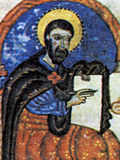Tovma Artsruni
Tovma Artsruni | |
|---|---|
 Title page of the 1985 Modern Armenian translation of Tovma Artsruni'sHistory of the House of Artsrunik | |
| Occupation | Historian |
| Known for | History of the House of Artsrunik |
Tovma Artsruni(Armenian:Թովմա Արծրունի;also known in English-language historiography asThomas Artsruni) was a ninth- to tenth-centuryArmenianhistorianwho authored theHistory of the House of Artsrunik(Patmut’iwn Tann Artsruneats’). Despite its title, the four-volume work not only relates the history of theArtsruniroyal family, of which Tovma was a member, but also comprehensively covers the history of Armenia.[1][2]
History of the House of Artsrunik
[edit]Tovma began writingHistorysometime in the 870s.[1]Much like other histories composed by Armenian historians, the first volume starts with the origins of the Armenian nation and ends in the middle of the fifth century. However, Tovma's most valuable contributions are found in the second and third volumes, which accurately detail Armenian life under the rule of theArab Caliphatesand in particular the 851 Arab military expedition led by theTurkicgeneralBugha al-Kabir,its subsequent consequences, and the establishment of the independentBagratid kingdom of Armenianorth of Lake Van.[1]Tovma was a relative of the Artsruni king ofVaspurakan,Gagik I,[3]and wrote a detailed account inHistoryabout the famous palace and church Gagik constructed onAkhtamarIsland.[4]
The precise date that Tovma completed his work is unknown, although some historians have determined that it was composed sometime after 905.[5]Tovma's work ends with an incomplete 29th chapter, yet several unknown authors (collectively calledAnanun'anonymous' in Armenian historiography) took it upon themselves to continue Tovma'sHistorydown to the 1370s and added an appendix andcolophon.[1]Tovma'sHistorywas first published in 1852 inConstantinoplein Armenian and was subsequently translated intoFrenchbyMarie-Félicité Brossetin 1862.[1]A translation into modern Armenian by Vrej Vardanyan was published in 1978.[6]Robert W. Thomsontranslated the history into English in 1985.[7]
References
[edit]- ^abcdeVardanyan, V. (1978). "Tʻovma Artsruni"Թովմա Արծրունի.In Simonyan, Abel (ed.).Haykakan sovetakan hanragitaranՀայկական սովետական հանրագիտարան[Armenian Soviet Encyclopedia] (in Armenian). Vol. 4. Yerevan. p.201.
{{cite book}}:CS1 maint: location missing publisher (link) - ^Thomson, Robert W.(1997). "Armenian Literary Culture through the Eleventh Century". InHovannisian, Richard G.(ed.).The Armenian People from Ancient to Modern Times, Volume I, The Dynastic Periods: From Antiquity to the Fourteenth Century.New York: Palgrave Macmillan. p. 228.ISBN0-312-10169-4.
- ^Redgate, Anne Elizabeth(1998).The Armenians.Cornwall: Blackwell. p. 7.ISBN0-631-22037-2.
- ^Thomson, "Armenian Literary Culture", p. 228.
- ^Sebeos(1999).The Armenian History Attributed to Sebeos.Translated and edited byRobert W. Thomson,James Howard-Johnston, and Tim Greenwood. Liverpool University Press. p. xxxv, n. 23.ISBN0-85323-564-3.
- ^Tovma Artsruni; Ananun [Anonymous] (1985).Patmutʻyun Artsrunyatsʻ tanՊատմություն Արծրունյաց տան(in Armenian). Translation and notes by V. M. Vardanyan.Yerevan University Publishing House.
- ^Thomas Artsruni (1985).History of the House of Artsrunikʻ.Translated and edited byRobert W. Thomson.Detroit: Wayne State University Press.

